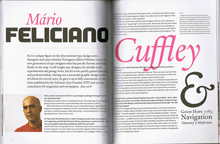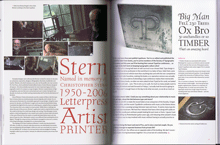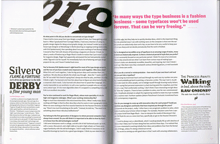“In the history of typography,” writes Jan Middendorp in his introduction to Creative Characters: the MyFonts interviews vol. 1, “the 1990s represented a phase of unprecedented democratization of the type design and production process… It seems the 2000s have accomplished a similar step for the user… Today, many managers, secretaries, bloggers or scrapbookers have preferences regarding the fonts they use.”
Creative Characters was launched in 2007 to give a peek behind the creative curtain and introduce “the faces behind the fonts,” the people who design type. The newsletter has been edited by Jan Middendorp, who has conducted interviews with type designers from all across the world of type. Twenty-six of them have been collected between covers in this book.
Middendorp is a good interviewer. He knows his subject, and he asks intelligent questions; he doesn’t ask long, rambling questions to get his own ideas across, but instead looks for for a response from the people he’s there to listen to. The nature of each interview, of course, varies with the interviewee.
Jim Parkinson, the lead-off subject, is self-deprecating in recounting his own notable history as a lettering artist. “Many people who worked for Rolling Stone in the early years still think it was the coolest job they ever had.” And: “Of all the people I have been lucky enough to bump into, Myron [McVay] taught me more about lettering and type design than everyone else put together, save Roger Black. I still do most things the ways Myron taught me.”
That’s not unusual. David Berlow, asked about his influences, says, “I’m still learning a lot from the people I’m supposed to be teaching.” Christian Schwartz, after receiving the Prix Charles Peignot from ATypI: “Although I have some really great collaborators, they’re all far away, so I spend almost all of my time working in my little office at home, by myself, which makes my job seem very anonymous. It’s a real honor to be recognized by my colleagues.”
The range of type designers interviewed here is wide; what they have in common, besides quality, is that they’re all active today, and they all have something to say about their careers and their work. Some dig deep into typographic history for their inspiration; others shun it. Some draw spectacular display faces; some craft meticulous text faces; some do both. The other thing they have in common is that at least some of their fonts are available from MyFonts.com.
These interviews all appeared first as e-mail newsletters from MyFonts. Like most of us, I receive these delightfully formated e-mails and, more often than not, put them aside in my inbox to read later. I find that it’s easier to read them in this invitingly designed physical book, which has spacious pages, colorful displays, readable text, and a format with flexible covers and loose sewn binding that is light enough to carry around and comfortable to hold in your lap and pore over at leisure. The page design not only shows off each designer’s typefaces, but has varied examples of other graphic designers’ real-world use of the faces – for example, a page of newspaper and magazine designs by Tony Sutton using a range of typefaces from Nick Shinn. Everything about this book is inviting and workable. This is only Volume 1; the series of interviews continues to appear in our e-mail, and I hope the next set will be collected soon in Volume 2.



